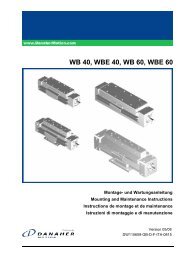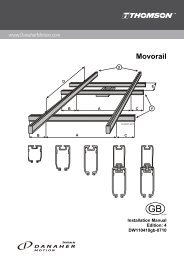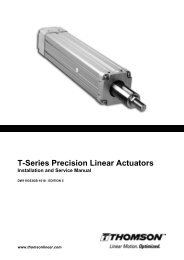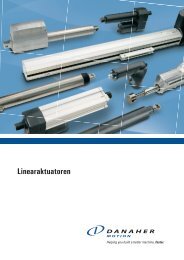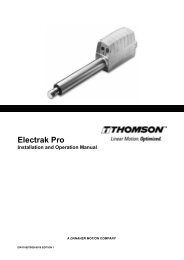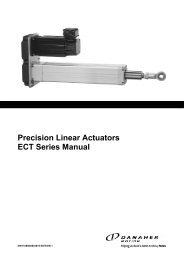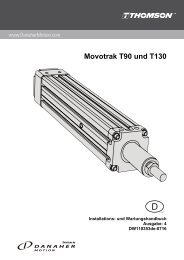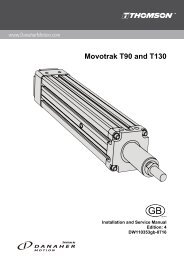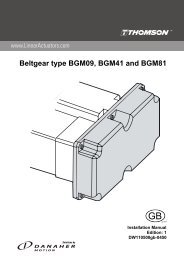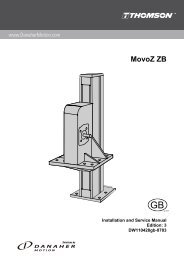- Page 1 and 2: Linear Units
- Page 3 and 4: Table of Contents Introduction ....
- Page 5 and 6: Introduction www.danahermotion.com
- Page 7: Belt Driven, Slide Guided Units Mai
- Page 11 and 12: Technical Introduction Maintenance
- Page 13 and 14: Linear Units with Ball Screw Drive
- Page 15 and 16: AccuSlide 2HBE 2HBE20 Parameter 2HB
- Page 17 and 18: WM40S Ball Screw Drive, Ball Guide,
- Page 19 and 20: WM40D Ball Screw Drive, Ball Guide,
- Page 21 and 22: WM60D Ball Screw Drive, Ball Guide,
- Page 23 and 24: WM60S Ball Screw Drive, Ball Guide,
- Page 25 and 26: WM60X Ball Screw Drive, Ball Guide,
- Page 27 and 28: WM80D Ball Screw Drive, Ball Guide,
- Page 29 and 30: WM80S Ball Screw Drive, Ball Guide,
- Page 31 and 32: WM120D Ball Screw Drive, Ball Guide
- Page 33 and 34: WV60 Ball Screw Drive, No Guides A1
- Page 35 and 36: WV80 Ball Screw Drive, No Guides A1
- Page 37 and 38: WV120 Ball Screw Drive, No Guides A
- Page 39 and 40: MLSM60D Ball Screw Drive, Ball Guid
- Page 41 and 42: MLSM80D Ball Screw Drive, Ball Guid
- Page 43 and 44: 2HBE10 Ball Screw Drive, Ball Guide
- Page 45 and 46: 2HBE20 Ball Screw Drive, Ball Guide
- Page 47 and 48: Linear Units with Ball Screw Drive
- Page 49 and 50: Movopart MD M100D Parameter M75D M1
- Page 51 and 52: WB40 Ball Screw or Lead Screw Drive
- Page 53 and 54: WB60 Ball Screw or Lead Screw Drive
- Page 55 and 56: M55 Ball Screw Drive, Slide Guide A
- Page 57 and 58: M75 Ball Screw Drive, Slide Guide A
- Page 59 and 60:
M100 Ball Screw Drive, Slide Guide
- Page 61 and 62:
M75D Ball Screw Drive, Slide Guide,
- Page 63 and 64:
M100D Ball Screw Drive, Slide Guide
- Page 65 and 66:
Linear Units with Belt Drive and Ba
- Page 67 and 68:
ForceLine MLSM Parameter MLSM80Z Pr
- Page 69 and 70:
WH40 Belt Drive, Ball Guide A1: dep
- Page 71 and 72:
WM60Z Belt Drive, Ball Guide, Short
- Page 73 and 74:
WM80Z Belt Drive, Ball Guide, Stand
- Page 75 and 76:
WM80Z Belt Drive, Ball Guide, Short
- Page 77 and 78:
M55 Belt Drive, Ball Guide A1: dept
- Page 79 and 80:
M75 Belt Drive, Ball Guide A1: dept
- Page 81 and 82:
M100 Belt Drive, Ball Guide A1: dep
- Page 83 and 84:
MLSM80Z Belt Drive, Ball Guide A1:
- Page 85 and 86:
Linear Units with Belt Drive and Sl
- Page 87 and 88:
M-Series Technical Presentation Cov
- Page 89 and 90:
M50 Belt Drive, Slide Guide A1: dep
- Page 91 and 92:
M55 Belt Drive, Slide Guide A1: dep
- Page 93 and 94:
M75 Belt Drive, Slide Guide A1: dep
- Page 95 and 96:
M100 Belt Drive, Slide Guide A1: De
- Page 97 and 98:
Linear Units with Belt Drive and Wh
- Page 99 and 100:
ForceLine MLSH MLSH60Z Parameter ML
- Page 101 and 102:
WH50 Belt Drive, Wheel Guide A1: de
- Page 103 and 104:
WH80 Belt Drive, Wheel Guide A1: de
- Page 105 and 106:
WH120 Belt Drive, Wheel Guide A1: d
- Page 107 and 108:
MLSH60Z Belt Drive, Wheel Guide A1:
- Page 109 and 110:
MLSH80Z Belt Drive, Wheel Guide A1:
- Page 111 and 112:
Linear Lifting Units SpeedLine, Mov
- Page 113 and 114:
Movo ZB ZB www.danahermotion.com Fe
- Page 115 and 116:
WHZ50 Belt Drive, Wheel Guide A1: d
- Page 117 and 118:
WHZ80 Belt Drive, Wheel Guide A1: d
- Page 119 and 120:
Z2 Ball Screw Drive, Slide Guide MG
- Page 121 and 122:
Z Ball Screw Drive, Slide Guide MGZ
- Page 123 and 124:
ZB Belt Drive, Ball Guide A1: depth
- Page 125 and 126:
Linear Rod Units VarioLine, Movotra
- Page 127 and 128:
Movotrak T T90 Parameter T90 T1 0 P
- Page 129 and 130:
WZ60 Ball Screw Drive, Ball Guide A
- Page 131 and 132:
WZ80 Ball Screw Drive, Ball Guide A
- Page 133 and 134:
T90 Ball Screw Drive, Slide Guide T
- Page 135 and 136:
T1 0 Ball Screw Drive, Slide Guide
- Page 137 and 138:
Accessories Accessory index www.dan
- Page 139 and 140:
Accessories Mounting Kits Mounting
- Page 141 and 142:
Accessories Mounting Kits Adapter P
- Page 143 and 144:
Accessories Mounting Kits Mounting
- Page 145 and 146:
Accessories Cover and Protection Ki
- Page 147 and 148:
Accessories Motors, Gears and Trans
- Page 149 and 150:
Accessories Motors, Gears and Trans
- Page 151 and 152:
Accessories Motors, Gears and Trans
- Page 153 and 154:
Accessories Motors, Gears and Trans
- Page 155 and 156:
Accessories Motors, Gears and Trans
- Page 157 and 158:
Accessories Motors, Gears and Trans
- Page 159 and 160:
Accessories Motors, Gears and Trans
- Page 161 and 162:
Accessories Motors, Gears and Trans
- Page 163 and 164:
KRG VL0/1/2-Ba53 Bevel Gears, data
- Page 165 and 166:
Accessories Motors, Gears and Trans
- Page 167 and 168:
Accessories Motors, Gears and Trans
- Page 169 and 170:
Accessories Motors, Gears and Trans
- Page 171 and 172:
Accessories Motors, Gears and Trans
- Page 173 and 174:
Accessories Electrical Feedback Dev
- Page 175 and 176:
Accessories Electrical Feedback Dev
- Page 177 and 178:
Accessories Electrical Feedback Dev
- Page 179 and 180:
Accessories Electrical Feedback Dev
- Page 181 and 182:
Accessories Electrical Feedback Dev
- Page 183 and 184:
Accessories Non Driven Units WH80N
- Page 185 and 186:
Accessories Non Driven Units WM60N
- Page 187 and 188:
Accessories Non Driven Units M75N A
- Page 189 and 190:
Accessories Multi Axis System Kits
- Page 191 and 192:
Additional Technical Data Linear Un
- Page 193 and 194:
Additional Technical Data Linear Un
- Page 195 and 196:
Additional Technical Data Linear Ro
- Page 197 and 198:
Drive Calculations Belt Driven Unit
- Page 199 and 200:
Deflection Calculations Examples of
- Page 201 and 202:
Ordering How to Order www.danahermo
- Page 203 and 204:
Ordering Keys Linear Units with Bal
- Page 205 and 206:
Ordering Keys Linear Units with Bal
- Page 207 and 208:
Ordering Keys Linear Units with Bal
- Page 209 and 210:
Ordering Keys Linear Units with Bel
- Page 211 and 212:
Ordering Keys Linear Units with Bel
- Page 213 and 214:
Ordering Keys Linear Units with Bel
- Page 215 and 216:
Ordering Keys Linear Units with Bel
- Page 217 and 218:
Ordering Keys Linear Lifting Units
- Page 219 and 220:
Ordering Keys Non driven Units WH40
- Page 221 and 222:
- Page intentionally left blank - w
- Page 224:
United Kingdom Danaher Motion Chart



